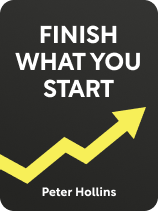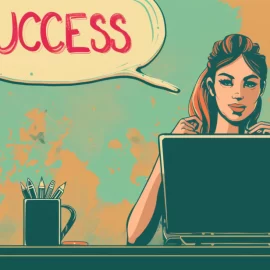

This article is an excerpt from the Shortform book guide to "Finish What You Start" by Peter Hollins. Shortform has the world's best summaries and analyses of books you should be reading.
Like this article? Sign up for a free trial here.
How can you boost your productivity and complete tasks more effectively? What strategies can help you stay focused and motivated?
In Finish What You Start, Peter Hollins offers practical advice on how to complete a task successfully. He explores techniques such as single-tasking, combining rewards with work, and maintaining a long-term perspective. These methods aim to enhance your productivity and help you achieve your goals.
Read on to revolutionize your approach to task completion.
Successful Task Completion
In his book, Hollins discusses what you can do while working to maximize your productivity. Let’s examine his three-part advice for how to complete a task successfully.
Tip #1: Work on One Task at a Time
Although multitasking can make it feel like you’re being unusually productive, Hollins asserts that it’s ineffective. Whenever you switch between tasks, you continue having thoughts about the previous task for some time. These thoughts distract you from the task at hand, resulting in decreased productivity and performance. Instead, you’ll get much more done if you focus solely on one task for an extended stretch of time.
With this in mind, Hollins recommends grouping tasks that require the same kind of thinking and completing them in a single session. This way, you’re essentially combining them into one task, allowing you to avoid the splintered attention that comes from repeatedly switching between tasks. For example, block out two hours every month to handle all your financial management tasks at once—pay your credit card and electricity bills, create a budget for next month, and review your investment portfolio.
| Train Yourself to Resist Constant Stimulation In Deep Work, Cal Newport also contends that you’ll be more productive if you focus on a single task without distractions. He notes that many people struggle to do this because they feel a compulsion to seek constant stimulation through new tasks. To combat this urge, the next time you’re in a situation where nothing is happening—for instance, if you’re sitting in your dentist’s waiting room—resist the urge to grab your phone. Let yourself be bored. Observe your surroundings or let your mind wander. The more you practice this, the better you’ll get at handling tasks without needing constant stimulation or distraction. Furthermore, Newport argues that it’s particularly important to strategically group all tasks that require the internet. The internet is designed to be addictive (as Newport discusses at length in Digital Minimalism), so it requires extra effort to avoid continuous task-switching and distraction. To stay focused, schedule specific times for using the internet and don’t go online at all outside of these times. Keep a notepad handy, and any time you think of something you need to do on the internet, write it down. When your scheduled internet time comes around, you’ll have a clear, focused agenda. |
Tip #2: Combine Treats With Tasks
According to Hollins, another way that you can maximize your productivity is by treating yourself at the same time you complete unpleasant but necessary tasks. For example, order delivery from your favorite local restaurant and eat it while researching how to set up a retirement fund.
Hollins explains that normally, your desire for short-term pleasure is at war with your desire for long-term improvements to your life: You must sacrifice one for the other. Unfortunately, short-term pleasure often wins, causing you to continually treat yourself and put off productive action. However, if you can find a way to make productive action pleasurable in the moment, you’ll resolve this conflict. Consequently, you’ll be motivated to finish tasks that you might have otherwise avoided indefinitely.
| The Neurochemistry of Combining Treats and Tasks In Atomic Habits, James Clear explains why pairing pleasant and unpleasant activities is a more effective strategy for long-term growth than you might expect. When you anticipate a pleasurable activity, your brain releases the neurotransmitter dopamine, which creates a sensation of desire and motivates you to act. This dopamine spike is stronger when you anticipate the reward than when you actually receive it, so craving a task can strongly motivate you to do it even if the task itself isn’t strongly pleasurable. Regularly combining treats with unpleasant tasks allows you to intentionally stir up cravings for the paired activity. If you perform these activities together for long enough, your brain will associate them. Then, thinking about the unpleasant activity will trigger dopamine release and craving as you anticipate the treat, and you’ll be motivated to do them both. This craving will help you sustain this behavior indefinitely. |
Tip #3: Resist Compulsions by Considering the Future
According to Hollins, an effective way to resist compulsions and distractions is by considering your life in its totality rather than just the immediate present.
If you’re being productive and you notice that you’re about to stop and surrender to a compulsion, stop and think about how you’ll feel about your decision in the future. You’ll gain a more accurate idea of how little this compulsion will please you in the long run, motivating you to resist it.
When you think about the future, consider imagining the worst-case scenarios that could occur if you gave into your compulsions or put off work. Hollins contends that fear of these negative futures may motivate you to make wiser decisions. For example, if you’re tempted to watch TV instead of spending time playing with your child, imagine how heartbroken you’d feel if they grew up emotionally distant and rarely talked to you as an adult. Use this strategy in moderation—obsessing over worst-case scenarios too often can cause excessive stress and anxiety, which can ruin your productivity.
Hollins argues that examining the big picture of your life can also help you stay committed to your life goals when you’re more seriously considering giving up. Strengthen your determination by asking yourself three questions: Ultimately, what do you want most? What do you need to do to get it? What actions should you avoid to get what you want? Your answers will clarify what you truly want to do in life.
(Shortform note: In High Performance Habits, Brendon Burchard also recommends clarifying the big picture of your life to help sustain your progress and growth. He elaborates that you should identify what you want and the actions you need to take in four major areas of your life: Self (the person you want to become), Social (the kinds of relationships you want to build), Skills (the specific strengths you want to develop), and Service (the difference you want to make in the world).)
| Counterpoint: You Can’t Predict What Will Make You Happy In Stumbling on Happiness, Daniel Gilbert argues that imagining how you’ll feel about a decision in the future and acting accordingly doesn’t always make you happy. On the contrary, these decisions often make you actively unhappy. This is because people tend to make inaccurate predictions about the future. For instance, we typically assume that the future will be more similar to the past than it really will be because we use our past experiences as a reference point. For example, someone might alienate their significant other with paranoid behavior because they suspect that they’ll be cheated on—like they’ve been cheated on in past relationships. Another way we make inaccurate predictions is by assuming things will turn out better than they really will. It feels better to imagine pleasant futures, so your brain tends to omit unpleasant possibilities when making predictions. If this is true, Hollins’s suggestion to imagine worst-case scenarios might help you arrive at a more realistic vision of the future by counteracting your natural optimistic bias. |

———End of Preview———
Like what you just read? Read the rest of the world's best book summary and analysis of Peter Hollins's "Finish What You Start" at Shortform.
Here's what you'll find in our full Finish What You Start summary:
- How to finish that ambitious project you’re putting off
- The type of mindset that will keep you motivated
- How your environment is distracting you from important things






